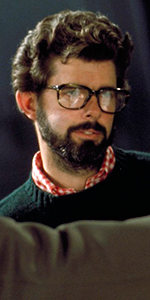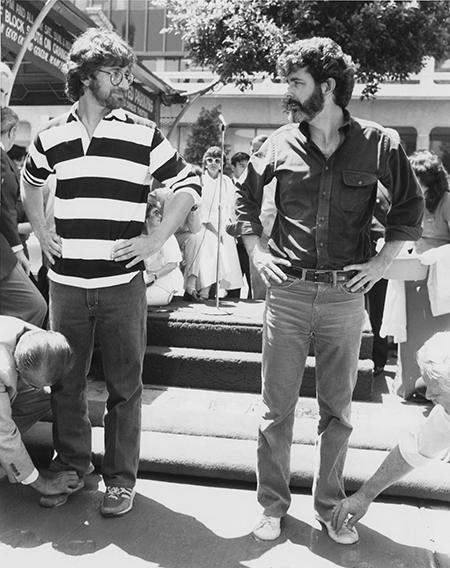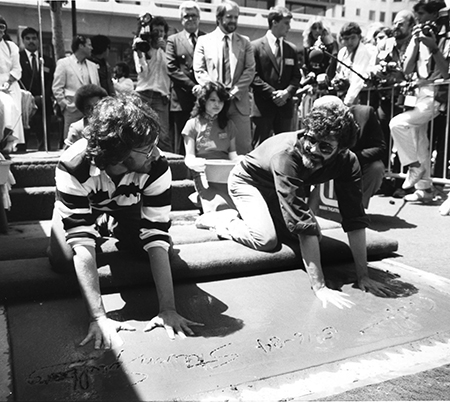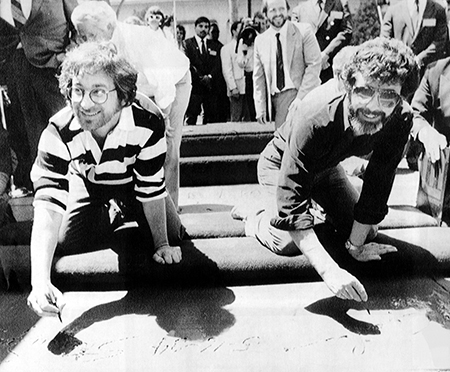|
 |
 |
 |
 |
|
|
George Lucas &
Steven Spielberg |
 |
| Footprinting Ceremony held on Wednesday, May 16, 1984 |
| |
Indiana Jones and the Temple of Doom Opened Nationwide on Wednesday, May 23, 1984 on 1,687 screens.
|
| |
Geroge Lucas and Steven Spielberg are two directors and producers who have changed the face of the worldwide movie business. Classically trained (in film schools), they both sought to combine filmic storytelling with a more modern interest in pop cultural themes, such as sharks, aliens, comic books, and the like.
Not exactly joined at the hip, the two have similar friends and interests (such as sharing composer John Williams), and have collaborated on many projects.
Although they both have considerable executive abilities, it was Lucas who, disliking directing, took his Star Wars franchise and founded his own film empire with special effects house Industrial Light & Magic, and sound studio Skywalker Sound, all located at Skywalker Ranch in Marin California.
Meanwhile, Spielberg has gone on to direct an astonishing string of films. Oh, and he also grouped together Jeffrey Katzenberg and David Geffin to form a new studio, DreamWorks SKG. |
|
|
|
|
| |
 |
 |
| Mann's Chinese Theatre, Hollywood, California. George Lucas / Steven Spielberg Forecourt block. Executed by John Tartaglia. Wednesday, May 16, 1984. 66 x 59 inches. |
 |
|
 |
 |
 |
 |
| George Lucas directing a scene from Star Wars, released in May, 1977. |
| |
|
 |
|
|
|
| George Lucas |
| |
Born: May 14, 1944, in Modesto, California
Age at the time of the ceremony: 40
|
| |
George Lucas was born in the small town of Modesto California. Obsessed with cars and racing, he lost interest when he was almost killed in a accident with another driver. Attending Modesto Junior College, he studied literature and began playing with movie equipment. He also became interested in underground filmmaking, eventually meeting up with cinematograpoher Haskell Wexler, who was a car buff also.
Transferring to USC to attend their cinema school, he met fellow student Steven Spielberg, who could not get into the program.
In an animation class, Lucas shot photos out of Life magazine, and turned in Look at Life (produced in 1965, and released on DVD in 2004). After graduating, Lucas attempted to join the Air Force, but his record of speeding tickets bounced him out. Drafted into the Army, he was 4-F due to being a diabetic.
He re-entered USC to concentrate on film production, where he made the legendary Electronic Labyrinth THX 1138 4EB (completed in 1967 and released on DVD in 2004). Lucas won a Warner Bros. contest and chose to hang with director Francis Ford Coppola, for whom he made the documentary The Making of "The Rain People" (released in August 1969). Coppola and Lucas opened their American Zoetrope studio in San Francisco and made their first picture THX 1138 (released by Warner Bros. in March 1971), with Robert Duvall. While the film flopped, it has become a classic.
Coppola suggested Lucas do something "warm." The result was
American Graffiti (released in August 1973), with Ron Howard and Richard Dreyfuss, one of the most successful hits of the early 1970s.
Wanting to make a film of Flash Gordon, but unable to get the rights, Lucas developed his Star Wars project and shopped it all over town. Only Alan Ladd Jr. head of 20th Century-Fox, picked it up; Lucas famously got all the rights to the picture; it would make him a multi-millionaire (or is that multi-billionaire?) Star Wars: Episode IV - A New Hope (which played the Chinese in May 1977), swept the world.
Lucas then retired to producing:
More American Graffiti (released in August 1979), tanked, but Star Wars: Episode V - The Empire Strikes Back (released in June 1980), did lots better. He wrote the story for Raiders of the Lost Ark (which played the Chinese in June 1981), but had his buddy, Steven Spielberg, direct it. Another monster hit, followed by Star Wars: Episode VI - Return of the Jedi (released in May 1983).
When their production of
Indiana Jones and the Temple of Doom (which played the Chinese in May 1984), was released, Lucas and Spielberg were asked to make their footprints together. Lucas returned to produce Star Wars: Droids for 14 episodes, aired over ABC, beginning in September 1985, then worked with director Jim Henson on Labyrinth (released in June 1986), with David Bowie. A major pothole for Lucas was Howard the Duck (released in August 1986), which was completely spurned by the public.
His next production was director Ron Howard's Willow (released in May 1988), with Val Kilmer, and he bankrolled Coppola's Tucker: The Man and His Dream (which played the Chinese in August 1988), with Jeff Bridges.
After the drubbing Temple of Doom received, Lucas brought the franchise back with both Indiana Jones and the Last Crusade (which played the Chinese in May 1989), with Harrison Ford and Sean Connery, and a television prequel, The Young Indiana Jones Chronicles, for 28 episodes, aired over ABC, beginning in March 1992. This was followed by The Adventures of Young Indiana Jones: Hollywood Follies, the first of what would become 20 television movies, aired over The Family Channel, beginning in October 1994.
Lucas used all of the toys in the Hollywood toybox to make the three "prequel" Star Wars films, Star Wars: Episode I - The Phantom Menace (which played the Chinese in May 1999), Star Wars: Episode II - Attack of the Clones (played the Chinese in May 2002), with a side trip to the traditionally animated Star Wars: Clone Wars for 25 episodes, aired over the Cartoon Network, beginnning in November 2003, and a computer animated relaunching for 122 episodes, aired over the Cartoon Network and Netflix, beginning in October 2008, and Star Wars: Episode III - Revenge of the Sith (released in May 2005).
Lucas produced the historical action picture
Red Tails (which played the Chinese in January 2012). At this point, Lucas sold his Lucasfilm Ltd. to the Walt Disney Company. Since then, he wrote the story and produced the computer animated musical Strange Magic (released in January 2015).
|
|
| |
|
|
|
|
| Steven Spielberg |
| |
Born: December 18, 1946, in Cincinnati, Ohio
Age at the time of the ceremony: 37
|
| |
While Steven Spielberg's grandparents had settled in Cincinnati in the 1900's, when Steven was only four, the family relocated to Haddon Township New Jersey. At age seven, they relocated again, to Phoenix Arizona. Bullied at school for his Jewish heritage, young Steven made the eight minute revenge western The Last Gun in 1959 in order to fulfill his Boy Scout merit badge in photography after he found his father's still camera was broken.
After making several more short films, he created a 140-minute science-fiction feature Firelight on a budget of $500. He rented the Phoenix Little Theatre to show it for one night, March 24, 1964. The take that night put the film in the clear — by one dollar.
Moving to Saratoga Califoirnia, Steven graduated high school, only to see his parents divorce. Living with his father in Los Angeles, Steven tried to enter the USC cinema school, but had to settle for Cal State University in Long Beach. While still in school, Speilberg got an internship at Universal Studios. Meanwhile, a pal put up $10,000 to produce the short film Amblin' (released in December 1968). Impressed, Universal president Sid Sheinberg signed Spielberg to a directing contract.
After directing a number of Universal television episodes, his big break came with the television movie Duel, aired over ABC in November 1971, with Dennis Weaver. Something about cars and the road seemed to resonate with this director. His first theatrical release became the couple-on-the-run story The Sugarland Express (which played the Chinese in April 1974). Spielberg so impressed its producers, Richard D. Zanuck and David Brown, that they had a book they wanted the wunderkind to direct a movie of.
Jaws (released in June 1975), was one of the great triumphs of filmmaking. Difficult to shoot, Spielberg stuck with it, making a film which changed the entire motion picture business after it made an astounding amount of money.
Spielberg could now write his own ticket. His Close Encounters of the Third Kind (released in December 1977), set the pattern: believeable fantasy. It made a ton of money. Teaming up with George Lucas, he directed Raiders of the Lost Ark (which played the Chinese in June 1981), then, he made his paean to childhood, E.T. the Extra-Terrestrial (released in June 1962), which made an obscene amount of money.
His and Lucas' sequel to Raiders, Indiana Jones and the Temple of Doom (which played the Chinese in May 1984), was such a misfire that Spielberg publicly apologized for it. It brought in the bucks anyway.
Spielberg's interest in personalities led him to tackle
The Color Purple (which played the Chinese in December 1985), introducing Whoopi Goldberg to the world. He next directed a story of a young boy let loose in war-torn China in Empire of the Sun (released in December 1968), with Christian Bale.
Spielberg knows, like others before him, that by providing a hit picture, he can make a more personal project. Hits like
Indiana Jones and the Last Crusade (which played the Chinese in May 1989), certainly don't hurt, but he had to direct Jurassic Park (released in June 1993), in order to get $22 million from Universal and 75 days to shoot Schindler's List (released in December 1993), which has to be considered his masterpiece.
After shooting
The Lost World: Jurassic Park (released in May 1997), he was able to make Amistad (released in December 1997), with Djimon Hounsou, which is a fascinating peek into the past. Saving Private Ryan (which played the Chinese in July 1998), with Tom Hanks, expressed Spielberg's interest in World War II, while A.I. Artificial Intelligence (which played the Chinese in June 2001), is a strange re-working of Peter Pan.
War of the Worlds (which played the Chinese in June 2005), with Tom Cruise, was contrasted with the grim Munich (released in December 2005). He directed War Horse (released in December 2011), and Lincoln (which had its West Coast Premiere at the Chinese in November 2012), which is the only Spielberg film to feature an Oscar-winning turn by a lead actor for Daniel Day-Lewis.
The Post (released in December 2017), with Tom Hanks and Meryl Streep was followed by Ready Player One (which played the Chinese in March 2018). Long delayed on account of the Covid lockdown, his remake of West Side Story played the Chinese (for a week) in December 2021. He directed a film of his own childhood fascination with movies, The Fabelmans with Michelle Williams (released in December 2022) |
|
|
|
|
| |
 |
 |
| Mann's Chinese Theatre, Hollywood California. George Lucas / Steven Spielberg Forecourt ceremony, Wednesday, May 16, 1984. Spielberg and Lucas consult one another as they become the first figures in the history of the Forecourt to make their imprints in tennis-shoes. They would not be the last. |
 |
 |
 |
| Mann's Chinese Theatre, Hollywood California. George Lucas / Steven Spielberg Forecourt ceremony, Wednesday, May 16, 1984. The two world-famous film directors are obviously enjoying every minute of this! |
 |
 |
 |
| Mann's Chinese Theatre, Hollywood California. George Lucas / Steven Spielberg Forecourt ceremony, Wednesday, May 16, 1984. Thank's right boys! Show us your grubby hands! |
 |
 |
 |
| Mann's Chinese Theatre, Hollywood California. George Lucas / Steven Spielberg Forecourt ceremony, Wednesday, May 16, 1984. The duo sign their names in the cement. |
| |
|
|
|
 |
|
 |
|
|